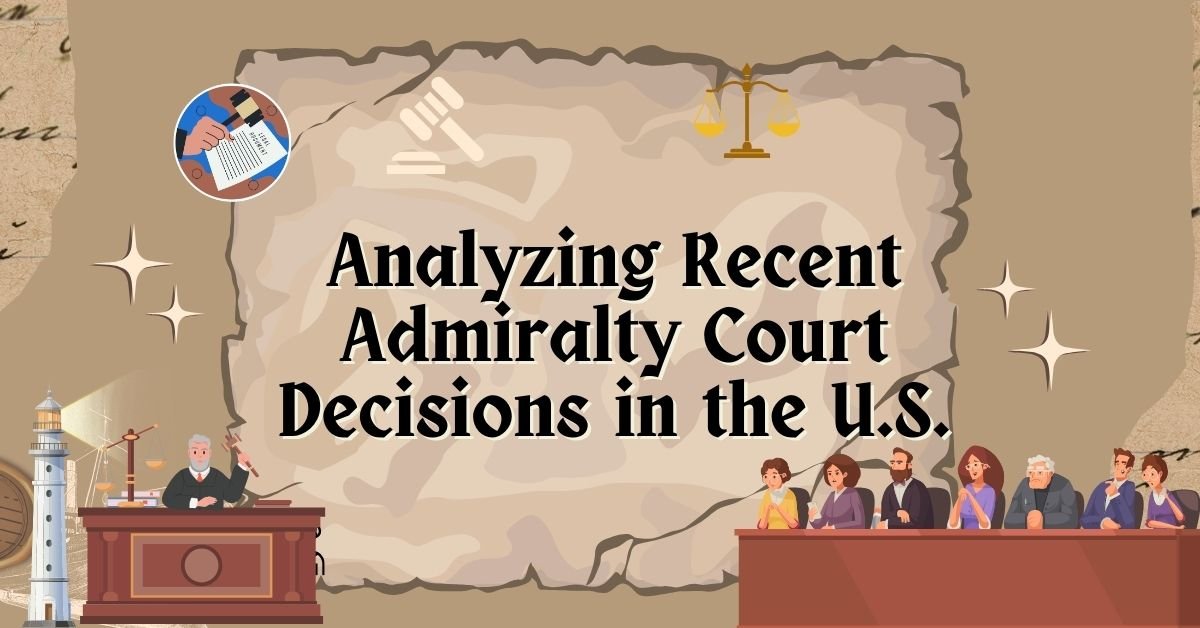1. Introduction
Admiralty law is a specialized branch of law that deals with legal matters that arise in navigable waters. It encompasses a wide range of issues, including maritime commerce, injuries at sea, environmental concerns, and more. Recent court decisions have played a pivotal role in shaping the application of admiralty law in the United States.
2. Understanding Admiralty Law
Admiralty law, often referred to as maritime law, is a unique legal framework that governs activities on the high seas and navigable waters. It encompasses both domestic and international aspects of maritime commerce and transportation.
3. Recent Admiralty Court Decisions: A Closer Look
Let’s explore some of the recent admiralty court decisions that have left a lasting mark on maritime law:
3.1. The “Scindia” Decision – Shaping Maritime Liability
The “Scindia” decision clarified the duties and responsibilities of vessel owners and operators regarding the safety of longshore workers. It has had a profound impact on maritime liability in port operations.
3.2. Jones Act Interpretations – Protecting Seafarer Rights
Recent interpretations of the Jones Act, a crucial piece of legislation protecting the rights of seafarers, have expanded its scope to provide enhanced legal protections for maritime workers.
3.3. The “Valero” Case – Environmental Consequences
The “Valero” case addressed environmental concerns related to oil spills and their impact on coastal areas. It underscored the importance of stringent regulations and liability in cases of environmental disasters.
3.4. Salvage and the “Smit Singapore” – Salvor’s Rights
The “Smit Singapore” case examined the rights and compensation of salvors in maritime salvage operations, shedding light on the legal intricacies of salvage efforts.
3.5. Limitation of Liability Act – Vessel Owner Protections
Court decisions related to the Limitation of Liability Act have affirmed vessel owners’ rights to limit their liability in cases of maritime accidents, providing legal protections for shipowners.
4. Impact on Maritime Industry
These recent court decisions have had a significant impact on the maritime industry, influencing safety practices, environmental responsibilities, and legal rights and obligations.
5. The Role of Precedent
In admiralty law, precedent plays a vital role in shaping future decisions. Recent court rulings serve as guiding principles for judges and lawyers when addressing similar legal issues.
6. Challenges and Controversies
While these court decisions have brought clarity to many aspects of admiralty law, they have also sparked debates and controversies within the legal and maritime communities.
7. Conclusion
Recent admiralty court decisions in the United States have provided valuable insights and directions in the ever-evolving field of maritime law. They serve as beacons, guiding legal practices and ensuring the protection of seafarers, the environment, and the interests of the maritime industry.
8. FAQs
Q1: What is the Jones Act, and how has it been recently interpreted?
The Jones Act is a federal law that provides legal protections for seafarers. Recent interpretations have expanded its scope to enhance seafarer rights and protections.
Q2: How do recent admiralty court decisions impact the maritime industry?
Recent decisions influence safety practices, environmental responsibilities, and legal rights and obligations within the maritime industry.
Q3: What is the significance of the “Valero” case in admiralty law?
The “Valero” case addresses environmental concerns related to oil spills and underscores the importance of stringent regulations and liability in such cases.
Q4: How do admiralty court decisions contribute to the development of maritime law?
Court decisions in admiralty law serve as precedent, guiding future legal practices and interpretations in the field.
Q5: What are some of the challenges and controversies surrounding recent admiralty court decisions?
Recent decisions have sparked debates and controversies within the legal and maritime communities, particularly regarding issues of liability and environmental protection. Play sprunki phase 28 Anytime, Anywhere!

Hi there! I’m at work browsing your blog from my new iphone 4!
Just wanted to say I love reading through your blog and look forward to all your posts!
Carry on the superb work!!